Schizophrenia Statistics: Schizophrenia statistics will help you to get insights into how mental disorders are emerging in younger and older generations.
To get detailed information about schizophrenia we have made key statistics on schizophrenia disorder which will provide you with deep information about this disorder.
The exact cause of schizophrenia is not yet fully understood, but it is believed that this disorder is mainly a complex interplay between genetic, environmental, and neurobiological factors.
There is no single cause of schizophrenia, but rather a combination of factors that increase the risk of developing the condition.
Table of Contents
- Early History of Schizophrenia
- What is Schizophrenia?
- Market Overview
- Schizophrenia Symptoms Statistics
- Key Facts About Schizophrenia
- How Common is Schizophrenia?
- Spain Schizophrenia Cases
- India Stress Levels
- Mental Health Worldwide
- Prevalence of Mental Illness
- The United States Mental Health Issues
- United States Mental Health Treatments
- Top 5 Companies Provide Medications
- Recent Developments
- Wrap Up
- FAQs
Early History of Schizophrenia
The ancient Greeks and Romans had a concept of “madness” that included symptoms that we now associate with schizophrenia, such as delusions and hallucinations.
In the 17th and 18th centuries, there was interest in mental illness and various theories were proposed to explain it.
The 19th century saw a significant shift in how mental illness was understood. Emil Kraepelin, a German psychiatrist, was one of the first to differentiate between different types of mental illness.
Take advantage of our unbeatable offer - buy now!

In the 20th century, advancements in neurosciences and psychology led to a greater understating of schizophrenia.
What is Schizophrenia?
Schizophrenia is a mental disorder that is characterized by a combination of symptoms such as delusions, hallucinations, disorganized thinking and speech, and a lack of motivation or interest in everyday activities.
Schizophrenia is a major chronic condition that affects about 1% of the population worldwide. People with schizophrenia disorder may have difficulty distinguishing between what is real and what is not, which can cause them to experience intense fear, anxiety, or confusion.
Market Overview
The Global Schizophrenia Drugs Market size is expected to be worth around USD 12.6 Billion by 2032 from USD 7.4 Billion in 2022, growing at a CAGR of 5.6% during the forecast period from 2023 to 2032.
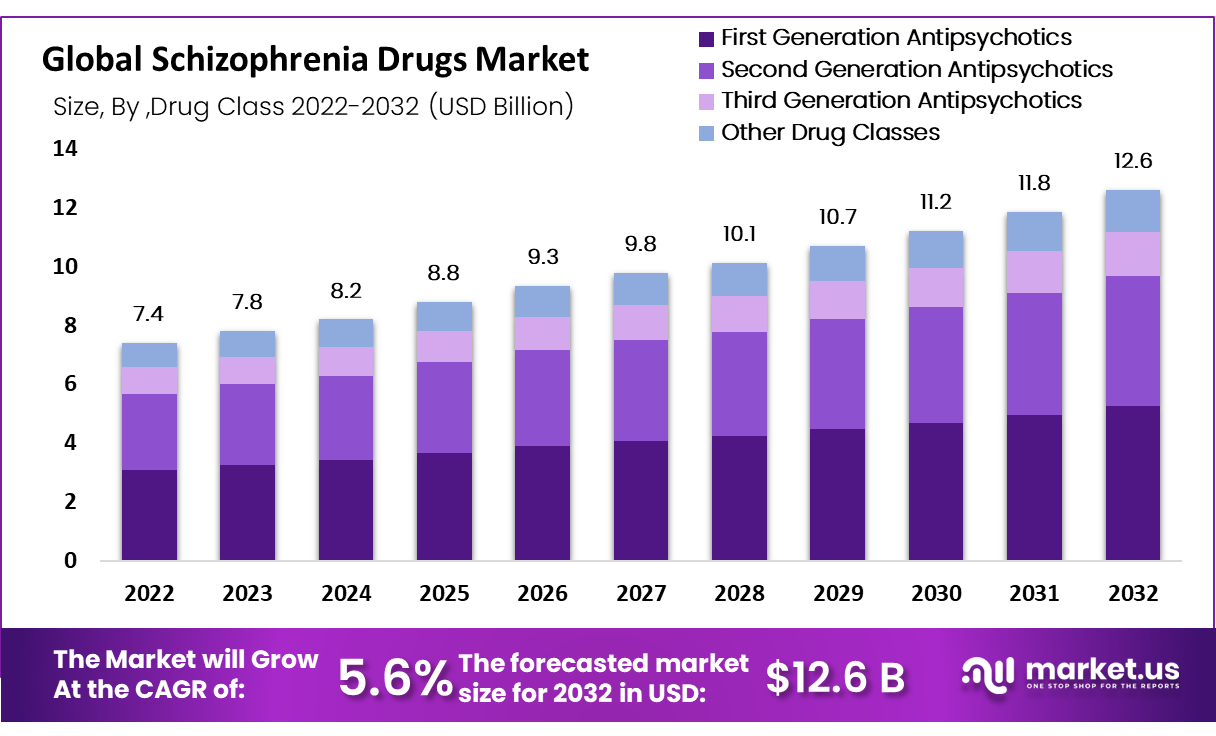
Schizophrenia Symptoms Statistics
The symptoms of schizophrenia can be grouped into three categories: positive symptoms, negative symptoms, and cognitive symptoms.
Positive Symptoms
- Hallucinations
- Delusions
- Disorganized thinking and speech
- Abnormal movements
Negative Symptoms
- Lack of emotion
- Reduced motivation
- Social withdrawal
- Difficulty speaking
Cognitive Symptoms
- Difficulty with memory and attention
- Poor problem-solving skills
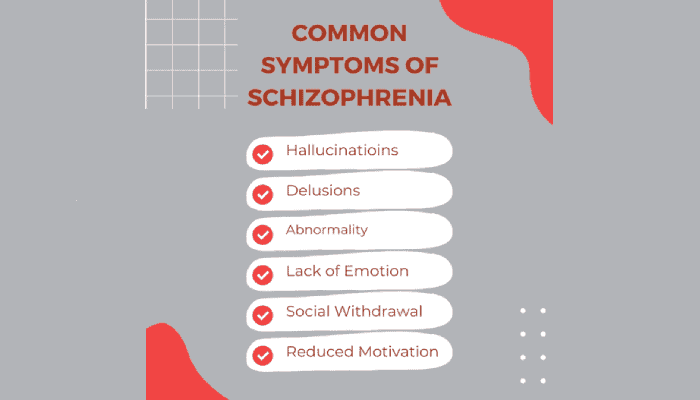
Key Facts About Schizophrenia
- Schizophrenia causes psychosis and is associated with disability and may affect all areas of life including personal, family, social, educational, and occupational functioning.
- discrimination, violation, and stigma of human rights of people with schizophrenia are common.
- More than 2 out of 3 people with psychosis in the world do not receive specialist mental health care.
Schizophrenia Statistics – Prevalence and Burden
Schizophrenia is a common disease but it can be a serious and chronic one.
The term schizophrenia is used to indicate how many people are currently living with a specific condition at or during a particular condition of time.
- About 1% of the global population is diagnosed with schizophrenia.
- Approximately 1.2% of Americans (3.2 million) have schizophrenia disorder.
- About 1.5 million people will be diagnosed with schizophrenia this year around the world.
- Most of the people with schizophrenia disorder are between the age of 16 to 25 years.
- Schizophrenia is one of the top 15 leading causes of disability worldwide.
- The average potential of life lost for individuals with schizophrenia in the United States is 28.5 years.
- About 4.9% of people with schizophrenia disorder die by suicide, the rate of that is greater than the general population, with higher risks in the early stages of illness.
(Source: mental help, NIMH.nih)
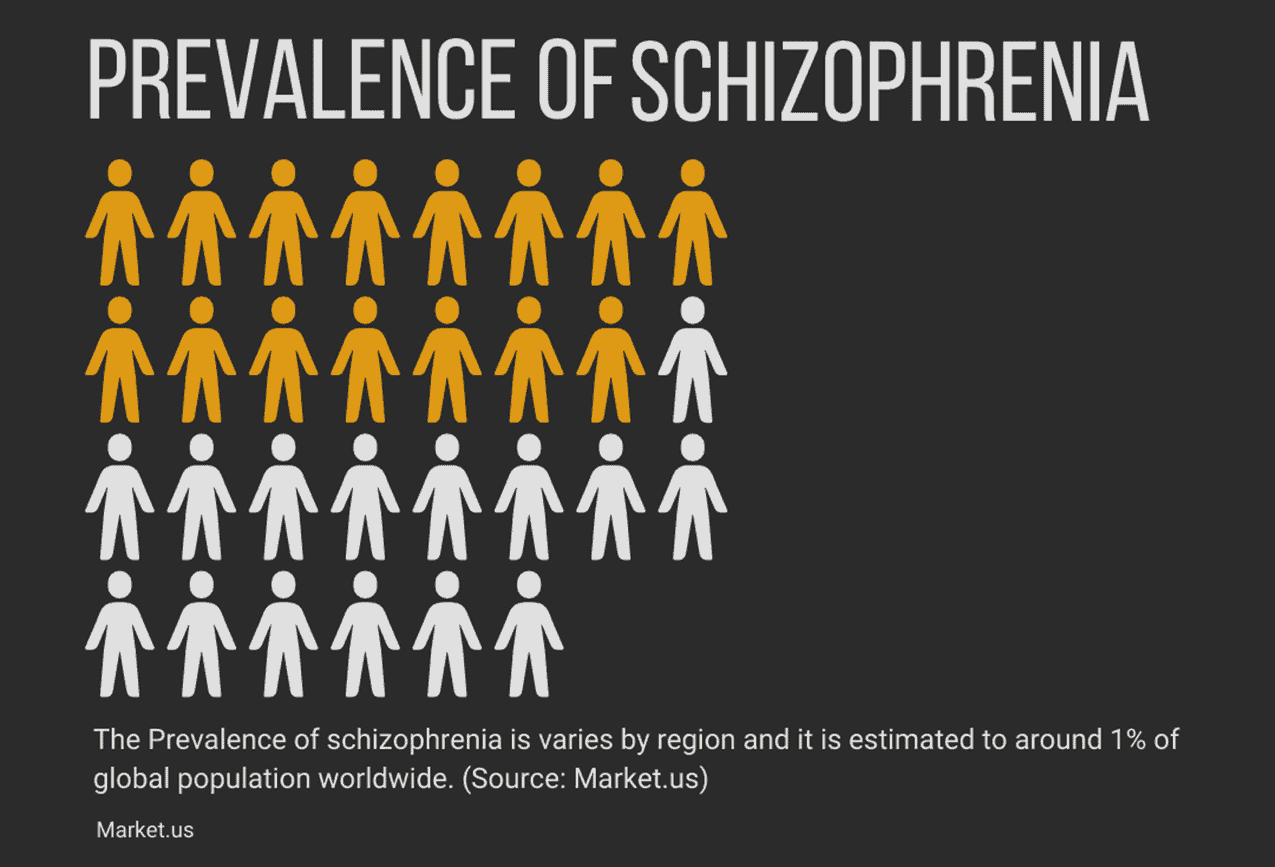
How Common is Schizophrenia?
- About 20 million people worldwide have this mental disorder.
- The annual number of new cases of schizophrenia is 1.5% per 10,000 people.
- About 20% of people with schizophrenia attempt suicide at least once.
- Schizophrenia affects approximately 24 million people or 1 in 300 about 0.32% worldwide.
- The rate of occurring of schizophrenia among adults is 1 in 222 (0.45%).
- People with schizophrenia are 2 to 3 times more likely to die early than the general population.
- Approximately 50% of people in mental hospitals have schizophrenia diagnoses.
- Only 31.3% of people with psychosis receive treatment.
- Schizophrenia is diagnosed 1.4 times more frequently in males than females.
- The mean age of the first hospital. admission for treatment of schizophrenia is between 25 to 35 years.
(Source: Wikipedia, singlecare, who)
Emergency Department Visits Related to Schizophrenia Among Adults Aged 18–64 in the United States
- More than 382,000 emergency department visits related to schizophrenia occurred each year among adults aged 18-64 years, with an overall ED visit rate of 20.1% per 10,000 adults.
- Overall visits related to schizophrenia for men are 26.5% per 10,000 approximately double the rate for women (13.8% per 10,000).
- About one-half of ED visits related to schizophrenia led to hospital admission (32.7%).
- 16.7% of schizophrenia patients transfer to a psychiatric hospital.
- About 50% of people with schizophrenia have recovered from the disorder.
- 80% of people with schizophrenia stay chronically ill for their entire lives.
(Source: CDC)
Schizophrenia Prevalence by Race
- About 21.1% of African Americans suffer from schizophrenia disorder.
- 19.9% of Hispanic Americans are suffering from this mental disorder.
- 5.4% of Asian Americans are suffering from schizophrenia disorder.
- African Americans are 4 times more likely than whites to be diagnosed with schizophrenia.
(Source: crossrivertherapy)
Spain Schizophrenia Cases
- In 2022, the number of schizophrenia cases registered in Spain amounted to around 207.6 thousand, up from about 193 thousand cases reported a year prior.
- Primary healthcare services in Spain attended approximately 52 thousand patients with schizophrenia.
(Source: Statista)

India Stress Levels
In the past few decades, India’s India’s disease epidemiology has transitioned from a high burden of communicable diseases.
- According to the World Health Organization (WHO), NCDs account for 74% of deaths worldwide and 66% of deaths are in India.
- 44% of Indians used meditation to lower anxiety levels and stress levels.
- 90% of Indians felt that information overload along with scattered information contributed to the highest levels of stress among working professionals.
(Source: Statista)
Mental Health Worldwide
Mental health has become more important worldwide as it contributes to a high burden of diseases as well as loss of life. Modern diagnostic categories are continuously adopting ethical treatment guidelines and include a wide range of disorders such as mood disorders, psychoses, personality disorders, addictions, and neurodevelopmental disorders.
Number of Suicides by Gender
- South Korea currently has the highest overall suicide rate of a country worldwide. The suicide rate among men in Korea is high compared to women.
- The suicide rate in the United States has risen since the year 2000.
- In 2022, 14.2% of deaths in the United States are due to suicide.
- The suicide rate in the United States is around 3.7 times more than in others.
- The suicide rate among men increases with age, with the highest rate found among men aged 65 years and older.
- About 52% of non-Hispanic white high school students in the United States have seriously considered attempting suicide in 2022.
- 35% of non-Hispanic Black students and 39% of Hispanic students attempted suicide in the past year.
- The states with high suicide rates include Alaska, South Dakota, and Wyoming.
(Source: Statista)
Prevalence of Mental Illness
Mental illness is the most common problem among people worldwide. Some age groups experience more mental illness than others.
It is estimated that the number of women suffering from mental illness is more than men. In the United States, the prevalence of mental illness in the past year is more common among females than males.
- 44.7 million Americans struggled with mental illness in the year 2022.
- In 2021, 1.2% of US men received mental health treatment or counseling.
- Of the majority of US adults not receiving mental health services, a total of 43% could not afford the cost of treatment.
- In 2020, there were 12,275 registered mental health treatment facilities in the US, within those, 9,634 were less than 24-hour outpatient facilities while 1,806 facilities were 24-hour inpatient facilities.
- Around 27% of females reported some type of mental illness in the year 2022 as compared to 18% of males.
- Around 8.1% of female respondents and 7.2% of male respondents in the United States reported having suffered from co-occurring mental illness and substance disorder in the past year 2022.
(Source: Statista)
The United States Mental Health Issues
Mental health issues are much like other health issues that can be mild but can also be life-altering, affecting the emotional, social, and psychological well-being of the person. The common types of illness include mood disorders, anxiety disorders, eating disorders, and personality disorders.
- In 2022, it was estimated that around 34% of those in the US aged 18-25 years suffered from some form of mental illness.
- 28% of those aged 26-49 years suffered from some form of mental illness.
(Source: Statista)
How common is depression in the United States?
- Depression is one of the most common disorders in the United States.
- Around 8.3% of US adults reported a major depressive episode in the last year 2022.
- 75% of women aged 18-20 reported major depressive episodes in 2022 compared to 8.6% of women aged 40-44 years.
- Around 32% of those in the US with a major depressive episode in the past year had serious thoughts of suicide compared to just 2% of those who did not have any major depressive episode.
(Source: Statista)
United States Mental Health Treatments
Treatment of mental health issues can come in many different forms and depend on the type of issues and severity of disorders. The common treatment methods include behavioral therapy, psychotherapy, and support groups.
- In 2021, around 50% of respondents in the United States with a major depressive episode reported they received treatment from a general family doctor.
- 43% of adults in the United States reported that they do not receive mental health services.
- 35% of adults said that they did not know where to go for such services.
(Source: Statista)
Schizophrenia Statistics – Prevalence of Mental Health Disorders in Italy 2021, By Diagnosis
- About 35.5% of people were treated for schizophrenia and psychoses disorders in 2021.
- 34.9% of patients are treated for depression disorder.
- 20.8% of patients are treated for neurosis and somatoform disorders.
- 13.8% of patients per 10,000 inhabitants will be treated for mania and bipolar affective disorder in 2021.
- 12.6% of patients are treated for behavioral and personality disorders.
(Source: Statista)
Prevalence of patients treated for mental health disorders in Italy in 2021, by diagnosis-related group (per 10,000 inhabitants)
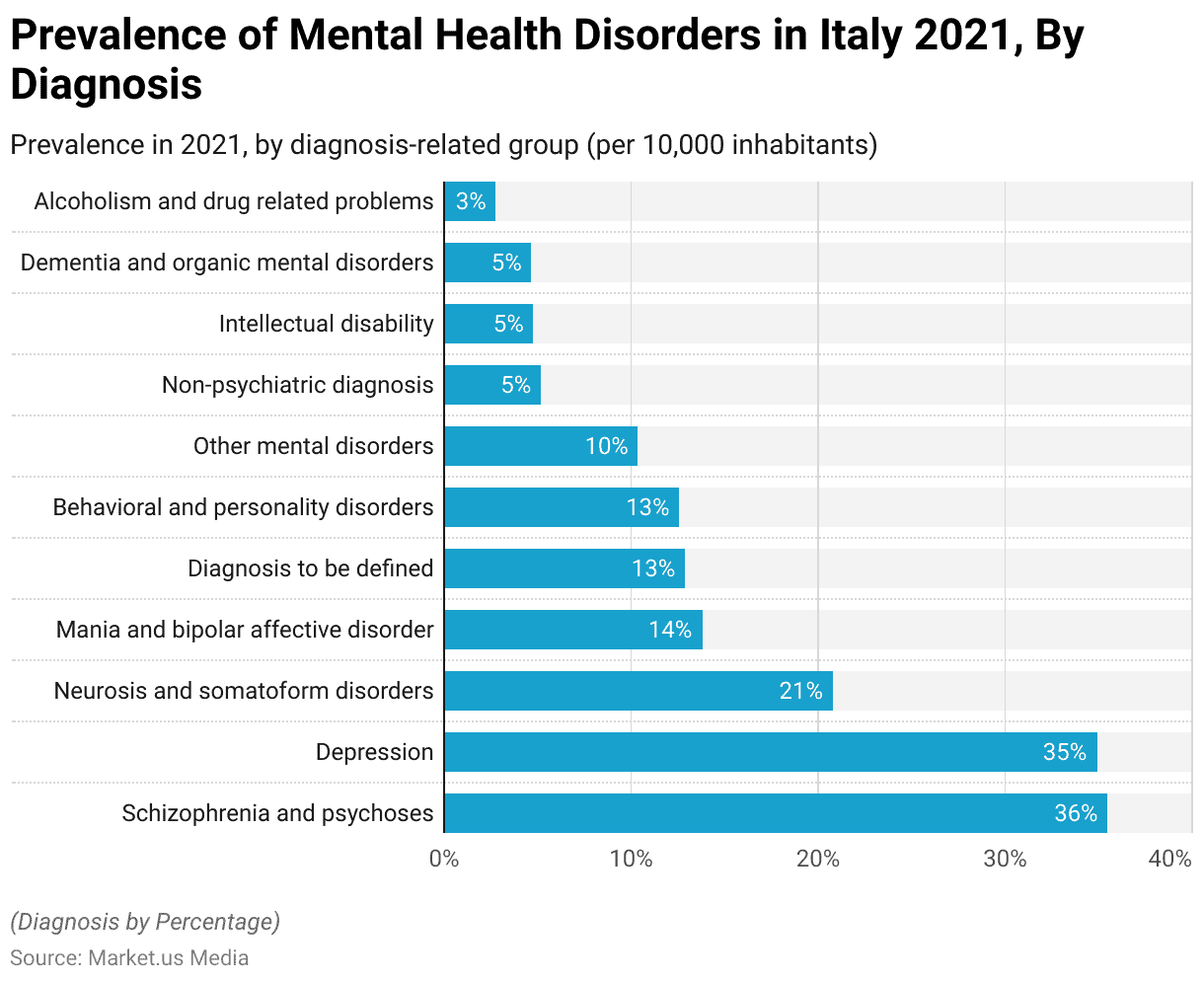
Schizophrenia Statistics – Hospital admissions due to mental health in Brazil 2021, by cause
- In 2021, around 62,000 hospital admissions due to schizophrenia were registered in Brazil.
- The highest number of patients admitted among other mental health conditions at that time. Emotional disorders followed, accounting for around 50,000 hospital admissions in that year.
- In 2018, schizophrenia contributed to 1.6% of all years lived with a disability (YLDs) in South American countries.
(Source: Statista)
Number of hospital admissions due to mental health problems in Brazil in 2021 by cause (in 1,000s)
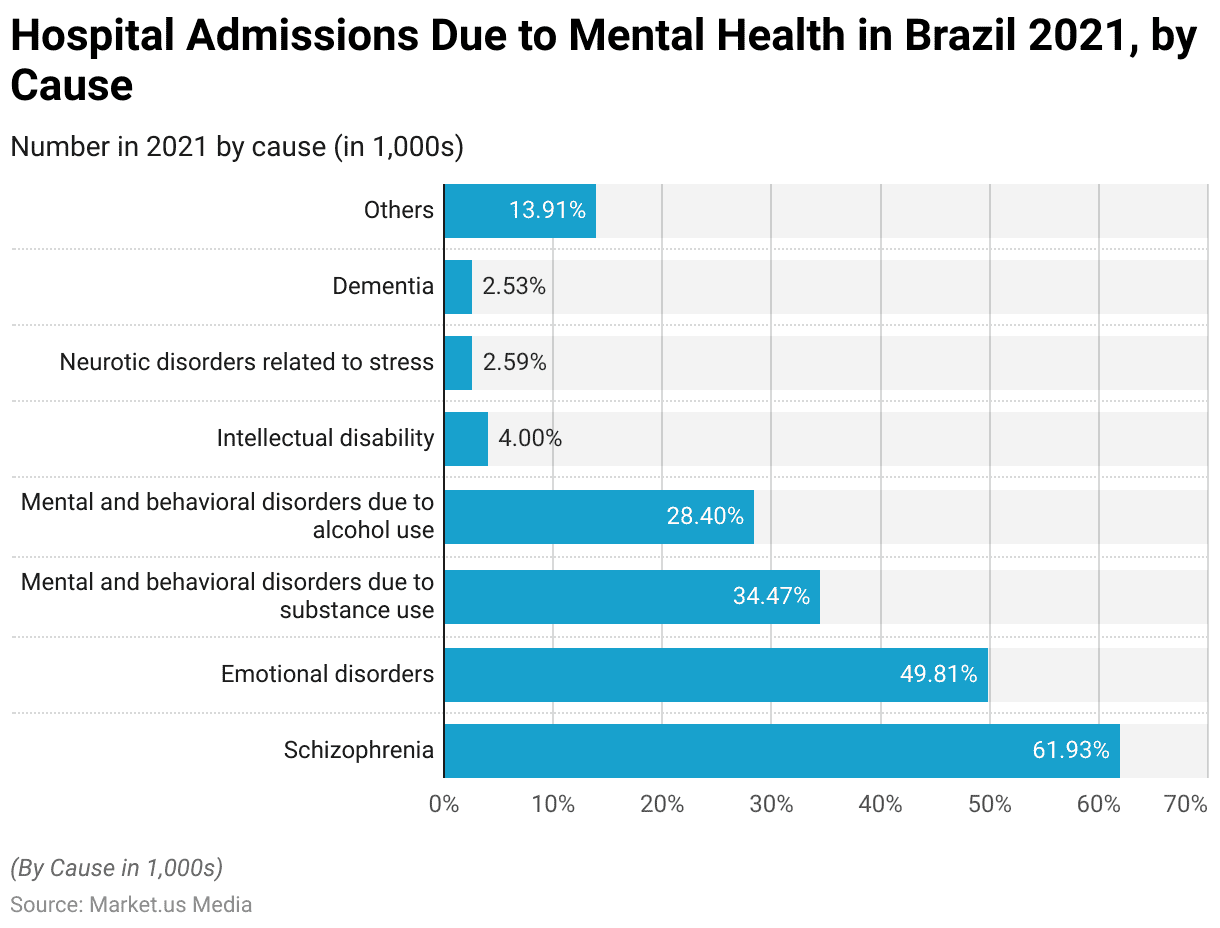
Schizophrenia Statistics – Number of patients quitting mental health treatment in Italy 2021, by diagnosis
- In Italy, the number of patients with a severe mental health diagnosis who left treatment amounted to 3,280 in 2021.
- Most of them suffered from severe depression (1,508).
- 756 people with severe mental health diagnoses are suffered from schizophrenia.
(Source: Statista)
This figure shows the number of patients with a diagnosis of a severe mental illness leaving treatment in Italy in 2021, by diagnosis.

Schizophrenia Statistics – Share of patients quitting mental health treatment in Italy 2021, by diagnosis
- In Italy, the percentage of patients with a severe mental health diagnosis who left treatment amounted to 0.69 percent in 2021.
- The majority of them suffered from severe depression or personality and behavioral disorders.
- This figure shows the percentage of patients with a diagnosis of a severe mental illness leaving treatment in Italy in 2021, by diagnosis.
(Source: Statista)
Percentage of patients with a severe mental health diagnosis who left treatment in Italy in 2021, by diagnosis

Schizophrenia Statistics – Prevalence of mental health conditions in Brazil as of 2022, by selected category (per 100,000 people)
- In 2022, stress was the mental health condition with the highest prevalence in Brazil, with around 47 thousand cases per 100,000 people.
- Anxiety and depression ranked second and third, affecting more than 8.1 thousand and 4.2 thousand people per 100,000 inhabitants in the South American country that year.
(Source: Statista)

Schizophrenia Statistics – Cost of Medicines for Treating Mental Health Disorders in Brazil 2022, by Category
- In 2022, medicines for treating post-traumatic stress disorder (PTSD) had the highest cost compared to the median global prices for the same drug in Brazil among selected categories of medicines for treating mental health conditions, with an estimated deviation of more than 100%.
- Medicines for treating bipolar disorder followed, costing approximately 96% more in Brazil than the global median price for the same medication.
- Meanwhile, the medicine used for stress treatment was nearly 10% cheaper in Brazil relative to the global median price.
- In 2022, Brazil had an overall mental health infrastructure index score of 76.04 points out of 100.
(Source: Statista)

Schizophrenia Statistics – Average Cost of Mental Health Care Services in Brazil 2022
- In 2022, the average cost of a 30-day addiction treatment rehabilitation program in Brazil amounted to nearly 1.8 thousand U.S. dollars or about 60 U.S. dollars per day.
- In comparison, a one-hour therapy session, and a day of mental health hospitalization, had an average cost of approximately 53 U.S. dollars and 17 U.S. dollars, respectively.
- That year, it was estimated that medicine for PTSD was 100 percent more expensive than the global average in the South American country.
(Source: Statista)

Top 5 Companies Provide Medications
Danish Pharmaceutical Company Lundbeck
Revenue of Lundbeck’s top products 2021-2022
- Among the products of Danish pharmaceutical company Lundbeck, the largest revenue in 2022 was made from Brintellix/Trintellix.
- The revenues from Brintellix/Trintellix reached roughly 4.3 billion Danish kroner that year.
- It was followed by Rexulti/Rxulti, with a revenue of roughly 3.9 billion Danish kroner.
- H. Lundbeck A/S is a Danish pharmaceutical company founded in 1915 with its headquarters in Copenhagen. The key products produced by the company are pharmaceuticals for the nervous system.
(Source: Statista)
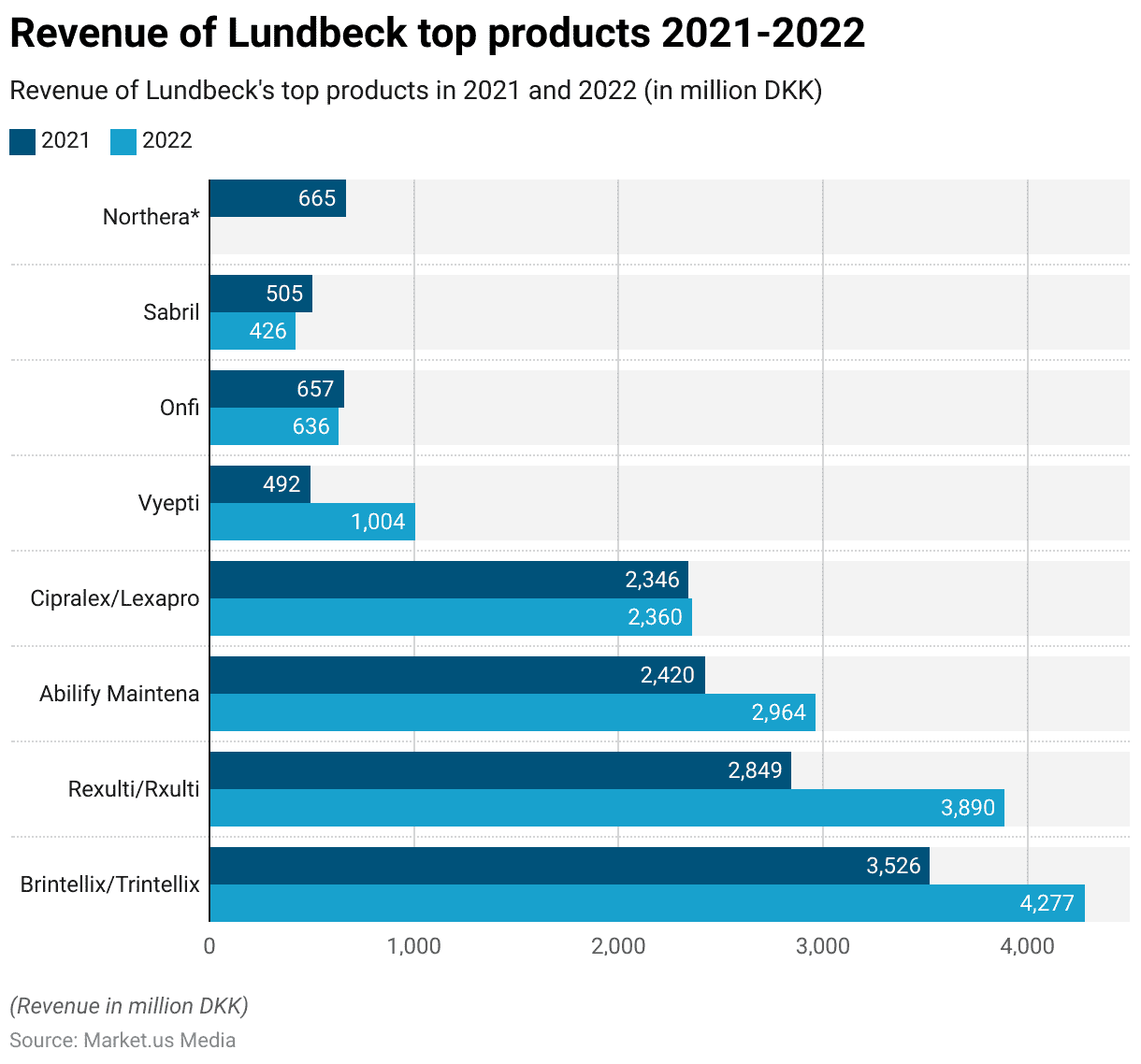
Janssen Pharmaceuticals
- This company provides Invega Sustenna, which is an injectable medication for the treatment of schizophrenia.
- In 2022, Johnson & Johnson generated approximately 95 billion U.S. dollars in sales
- As of 2022, it was ranked as the leading pharmaceutical company worldwide in terms of total revenue generated.
- As of 2022, Johnson and Johnson was not among the big pharmaceutical companies with the highest R&D intensity.
- Janssen Pharmaceuticals is a part of Johnson & Johnson, the USA-based Healthcare Corporation.
- Around $4.5 billion investments in research & development annually.
(Source: Statista)
Pfizer
- Pfizer provides Geodon, an oral medication for the treatment of schizophrenia.
- In 2022, the company’s total revenue exceeded 100 billion U.S. dollars for the first time, a record among global drug manufacturers.
- Pfizer’s products are available in many countries worldwide and as of 2022, the company had some 170 research and development projects.
(Source: Statista)
Eli Lilly and Company
- Eli Lilly and Company provides Zyprexa, an oral medication for the treatment of schizophrenia.
- In 2022, the company generated 28.5 billion U.S. dollars of revenue.
- In 2022, the company generated some 1.75 billion U.S. dollars of its revenue in Japan.
(Source: Statista)
AstraZeneca
- AstraZeneca provides Seroquel, an oral medication for the treatment of schizophrenia.
- In 2022, British-Swedish biopharmaceutical company AstraZeneca generated revenues of some 43 billion U.S. dollars, the fifth consecutive year with significant growth.
(Source: Statista)
COVID-19 Impact on Patients Who Have Schizophrenia Disorder
COVID-19 has a significant impact on mental health worldwide. People with schizophrenia are particularly vulnerable to its effects. Propels with schizophrenia experienced increased stress and anxiety due to fear of coronavirus spreading and change in routine. People with schizophrenia are known to suffer from high prevalence of respiratory tract infections than the general population.
- The prevalence of schizophrenia in 7341 Korean patients with COVID-19 was 3.6%.
- The prevalence of schizophrenia during the crisis of COVID-19 was higher at 5.4%.
- 50,750 patients admitted to hospital for COVID-19 in France.
- The prevalence of schizophrenia was 1.6% in the West.
- The United States reported a prevalence of 2% of psychotic disorders in 62,354 patients with COVID-19.
(Source: frontiersin)
Old age and clinical comorbidities raise mortality rates for patients with COVID-19
- About 70% of all patients with schizophrenia often have 1 or more clinical conditions.
- The smoking rate among patients with schizophrenia increased from 50% to 90% during the pandemic.
(Source: update)
| Psychiatric Symptoms | Percentage |
| Anxiety | 12-20% |
| Depression | 15-25% |
| Insomnia | 8% |
| Traumatic distress | 35-49% |
Recent Developments
Clinical Trials and Drug Development:
- PharmaCorp initiated Phase III clinical trials for a novel antipsychotic medication targeting negative symptoms of schizophrenia, with promising preliminary results showing a 30% improvement in symptom severity scores.
- Biotech Innovations received FDA approval for a long-acting injectable formulation of an established antipsychotic drug, offering improved treatment adherence and reducing relapse rates by 40% compared to oral medications.
Acquisitions and Partnerships:
- MentalHealth Solutions acquired SchizoCare Therapeutics, gaining access to its pipeline of innovative treatments for schizophrenia, with a focus on personalized medicine approaches.
- Research Foundation XYZ partnered with PharmaGiant Inc. to advance research in schizophrenia genetics, with a joint investment of $50 million allocated for genome-wide association studies and biomarker identification.
New Treatment Modalities:
- MindTech introduced a digital therapeutic platform for cognitive remediation in schizophrenia patients, demonstrating a 25% improvement in cognitive function and daily living skills after six months of intervention.
- VirtualReality Therapy launched immersive virtual reality exposure therapy for schizophrenia patients experiencing auditory hallucinations, resulting in a 30% reduction in symptom severity scores.
Funding and Grants:
- The National Institute of Mental Health (NIMH) allocated $100 million in research grants for studies investigating novel therapeutic targets and interventions for schizophrenia, aiming to accelerate the development of innovative treatment options.
- Schizophrenia Research Foundation received a $20 million endowment from philanthropic donors to support research initiatives focused on understanding the neurobiological mechanisms underlying schizophrenia and identifying potential biomarkers for early diagnosis.
Epidemiological Studies:
- A comprehensive epidemiological study conducted by the Global Health Institute revealed a prevalence rate of 0.5% for schizophrenia worldwide, with an estimated 20 million individuals affected globally.
- Regional disparities in schizophrenia prevalence were observed, with higher rates reported in urban areas compared to rural regions, highlighting the influence of environmental factors on disease risk.
Telepsychiatry Services:
- Telepsychiatry platforms such as SchizoConnect expanded their services to provide remote psychiatric consultations and therapy sessions for individuals with schizophrenia, increasing access to specialized mental healthcare in underserved communities.
- Adoption of telepsychiatry services surged during the COVID-19 pandemic, with a 50% increase in virtual consultations for schizophrenia patients, reflecting the growing acceptance of telehealth solutions in mental healthcare delivery.
Policy Initiatives:
- Government agencies implemented mental health parity laws and increased funding for community mental health programs to improve access to care for individuals with schizophrenia, aiming to reduce treatment disparities and promote early intervention strategies.
- Advocacy organizations advocated for increased public awareness and destigmatization efforts surrounding schizophrenia, leading to improved societal acceptance and support for individuals living with the condition.
Wrap Up
Schizophrenia Statistics – The burden of schizophrenia is increasing globally, especially in low and middle-income countries where infant childhood mortality has declined. Schizophrenia is a widespread mental disorder that affects millions of people across the globe, regardless of age, gender, or socio-economic status.
Early diagnosis of schizophrenia can help to improve outcomes and quality of life for individuals with this disorder. Many people across the globe are not receiving the care they need due to factors such as stigma, lack of awareness, and inadequate mental health infrastructure.
Further research is needed to better understand the causes, risk factors, and potential treatments for schizophrenia. Overall, the schizophrenia statistics highlight the need for increased awareness, resources, and support to address this major and challenging mental disorder.
Also, it is very important to consider that, the lack of effective treatment for this critical mental disorder will impact individuals and their families.
FAQs
Schizophrenia is a mental disorder that is characterized by a combination of symptoms such as delusions, hallucinations, disorganized thinking and speech, and a lack of motivation or interest in everyday activities.
The symptoms of schizophrenia can be grouped into three categories: positive symptoms, negative symptoms, and cognitive symptoms.
Positive Symptoms
Hallucinations
Delusions
Disorganized thinking and speech
Abnormal movements
Negative Symptoms
Lack of emotion
Reduced motivation
Social withdrawal
Difficulty speaking
Cognitive symptoms
Difficulty with memory and attention
Poor problem-solving skills
The prevalence of schizophrenia varies by region and is estimated to be around 1% of the global population.
The treatment of schizophrenia typically involves a combination of medications, therapy, and support services. Antipsychotic medications can help manage the positive symptoms of schizophrenia, while therapy can help with cognitive and negative symptoms. Support services, such as vocational rehabilitation and housing assistance, can help people with schizophrenia live independently and improve their quality of life.
Discuss your needs with our analyst
Please share your requirements with more details so our analyst can check if they can solve your problem(s)



